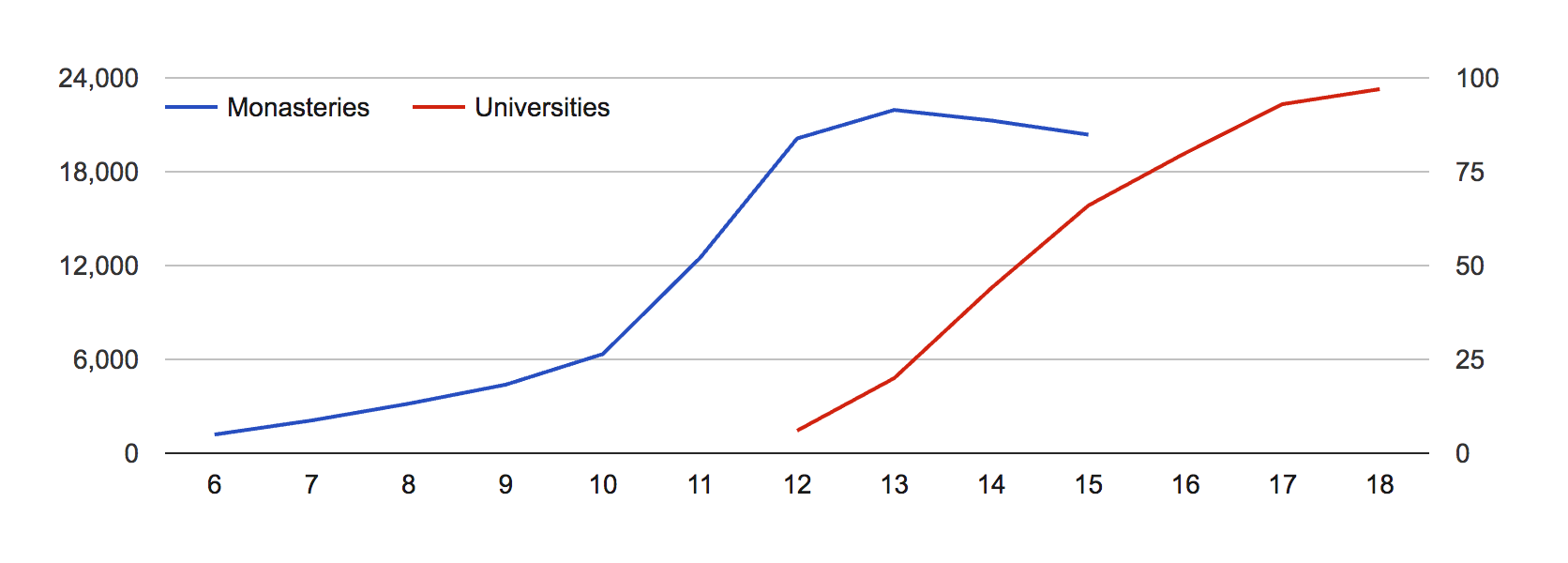This entry gives a basic overview of both the historical perspective on higher education as well as recent trends and future projections.
Notice: This is only a preliminary collection of relevant material
The data and research currently presented here is a preliminary collection or relevant material. We will further develop our work on this topic in the future (to cover it in the same detail as for example our entry on World Population Growth).
If you have expertise in this area and would like to contribute, apply here to join us as a researcher.
More information on the rise of education across the world is available here, while a more detailed discussion of the returns to higher education can be found here.
All our charts on Tertiary Education
Share of the population with tertiary education
This map shows the share of population older than 14 years that has completed tertiary education.
In 2010 30% of South Koreans had tertiary education. Ireland and the US follow with the second and highest share of tertiary education.
In many of the world’s poorest countries less than 1% have completed tertiary education.
Enrollment in tertiary education
The chart shows in 2014 globally 34% of those within 5 years of finishing secondary education were enrolled in tertiary education.
Between different world regions there were large differences.
Enrollment in tertiary education over time
This chart shows the rise of the gross enrollment ratio in tertiary education across world regions.
It is possible to add particular countries to this plot (by clicking ‘add countries’) or to view this on a world map (by switching to the map view).
The map shows the total government expenditure on tertiary education as a percentage of GDP.
The map shows the share of students studying abroad.
A corresponding map showing the share of students arriving from abroad can be seen here.
In the past, there were very few higher education institutions since only a small fraction of the population was able to read or write. During this early period, centers of education mostly had a religious focus and trained clergy. In Western Europe these centers were monasteries, while in the Islamic world these were madrasas.
The chart shows the increasing number of monasteries in Western Europe between the 6th and the 15th century. Between the end of the first millennium and the 13th century the number grew rapidly, before coming to a halt and declining.
As the rise of monasteries came to a halt a new form of a higher education institution evolved: the university. These secular institutions began to rise as monasteries slowly started to decline, and the religious powers lost their monopoly on higher education.
Still, this was only the beginning; as late as the 18th century there were still fewer than 100 universities in Western Europe.
The raw data on monasteries and universities in Europe over the long-run published by Buringh and Van Zanden is available on a separate page.
Total number of monasteries and total number of universities in Western Europe, 600-18001

The visualisations show estimations and projections from 1970 to 2050 of higher education by country.
The numbers completing degrees is expected to increase around the world as advanced skills become more important in both developing and developed economies.
For more information on how these projections are constructed, visit the projections of future education page here.
- Data: Comprehensive data on enrollments, out-of-school children, repetition, completion, gender, teachers, education expenditures, learning outcomes, educational attainment, education equality, literacy, population, labor, and EMIS.
- Geographical coverage: Global by country
- Time span: 1999 onwards
- Available at: http://data.uis.unesco.org/
- Data: indicators on educational attainment, enrolment, attendance, teachers, financing and more
- Geographical coverage: Global, over 200 countries
- Time span: 1970 to most recent data year; Projections to 2050
- Available at: It is online here
Van Zanden, Jan Luiten. The long road to the industrial revolution: the European economy in a global perspective, 1000-1800. Vol. 1. Brill, 2009.
- Data: Number of monasteries by country
- Geographical coverage: Western Europe
- Time span: 600-1600
- Available at: http://www.brill.com/long-road-industrial-revolution
Buringh, Eltjo, and Jan Luiten Van Zanden. “Charting the “Rise of the West”: Manuscripts and Printed Books in Europe, a long-term Perspective from the Sixth through Eighteenth Centuries.” The Journal of Economic History 69, no. 02 (2009): 409-445.
- Data: Number of universities by country
- Geographical coverage: Western Europe
- Time span: 1200-1800
- Available at: The Journal of Economic History
- Data: Educational by level of attainment, population projections
- Geographical coverage:
- Education: 120 countries
- Population: 190 countries
- Time span: 1970-2050
- Education: 1970-2050
- Population: 1970-2100
- Available at: